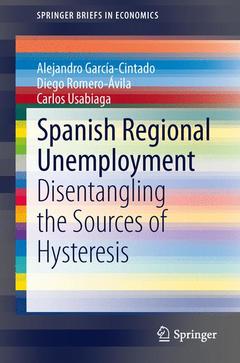Description
Spanish Regional Unemployment, 2014
Disentangling the Sources of Hysteresis
SpringerBriefs in Economics Series
Authors: García-Cintado Alejandro, Romero-Ávila Diego, Usabiaga Carlos
Language: English
Subjects for Spanish Regional Unemployment:
52.74 €
In Print (Delivery period: 15 days).
Add to cart68 p. · 15.5x23.5 cm · Paperback
Description
/li>Contents
/li>Biography
/li>Comment
/li>
Introduction.- PANIC Analysis of Spanish Regional Unemployment.- Explaining the Common Stochastic Trend in Spanish Regional Unemployment: Granger-Causality Analysis.- Policy Considerations Drawn from Our Results.- Concluding Remarks.- Appendix.
Alejandro García-Cintado is Assistant Professor at Pablo de Olavide University (Seville) and Visiting Professor at Paris-Est Créteil Val-de-Marne University (France). His research interests lie in the fields of Macroeconomics and International Economics.
Diego Romero-Ávila is Associate Professor at Pablo de Olavide University. He has been Research Fellow at the European Central Bank and Visiting Professor at Vienna University of Economics and Business. His research interests lie in the fields of Macroeconomics and Development Economics. He has published articles in such academic journals as International Economic Review, Journal of Money, Credit and Banking, Canadian Journal of Economics, World Development, Economic Inquiry, Journal of Banking and Finance and European Journal of Political Economy among others.
Carlos Usabiaga is Full Professor of Economics at Pablo de Olavide University. He has been Visiting Researcher at the London School of Economics, Northwestern University (USA), European University Institute (Florence), CEMFI (Madrid) and FEDEA (Madrid). He has been Head of the Department of Economics at Pablo de Olavide University for 8 years. He has published widely on Macroeconomic and Labour topics. He was the author of a book published by Macmillan in 1999 and translated into Spanish. He has published articles in such academic journals as Empirical Economics, Economic Modelling, Southern Economic Journal, Contemporary Economic Policy, Applied Economics, among others.
These books may interest you

Entrepreneurship in SpainA History 160.25 €

Combatting Unemployment 37.41 €

Theory of Unemployment 56.31 €

